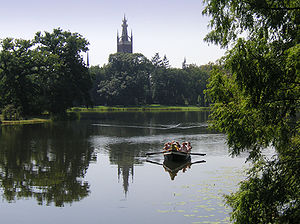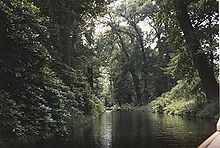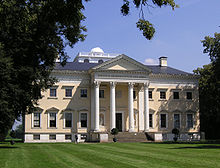- Dessau-Wörlitz Garden Realm
-
Garden Kingdom of Dessau-Wörlitz * UNESCO World Heritage Site
Country Germany Type Cultural Criteria ii, iv Reference 534 Region ** Europe and North America Inscription history Inscription 2000 (24th Session) * Name as inscribed on World Heritage List
** Region as classified by UNESCOThe Dessau-Wörlitz Garden Realm, also known as the English Grounds of Wörlitz, is one of the first and largest English parks in Germany and continental Europe. It was created in the late 18th century under the regency of Duke Leopold III of Anhalt-Dessau (1740-1817), returning from a Grand Tour to Italy, the Netherlands, England, France and Switzerland he had undertaken together with his friend architect Friedrich Wilhelm von Erdmannsdorff. Both strongly influenced by the ideals of The Enlightenment, they aimed to overcome the formal garden concept of the Baroque era in favour of a naturalistic landscape as they had seen at Stourhead Gardens and Ermenonville. Today the cultural landscape of Dessau-Wörlitz encompasses an area of 142 km2 (55 sq mi) within the Middle Elbe Biosphere Reserve in the German state of Saxony-Anhalt.
Contents
Oranienbaum
The Gardens had its origin in the 17th century, when the marriage of Leopold's great-grandfather Prince John George II of Anhalt-Dessau to the Dutch princess Henriette Catharina, daughter of Prince Frederick Henry of Orange (Dutch: Oranje), in 1659 brought a team of engineers and architects from the Low Countries under the supervision of architect Cornelis Ryckwaert to lay out the town, the palace and a Baroque garden in the former settlement of Nischwitz, which was renamed Oranienbaum in 1673. The Dutch influence remained prevalent in the Principality of Anhalt-Dessau for many decades.
Oranienbaum Palace was finished in 1683 as the summer residence of Henriette Catharina, where she retired after the death of her husband in 1693. The rich furnishing includes leather wallpapers and a dining room equipped with Delft tiles. From 1780 on Duke Leopold III had the palace and the park rebuilt in a Chinese style, according to the theories of Sir William Chambers, with several arch bridges, a tea house and a pagoda. In 1811, the orangery was built, with 175 m (574 ft) in length one of the largest in Europe, which still serves to protect a wide collection of citrus plants. Oranienbaum Palace together with the park and the geometrical settlement conception forms one of the few original Dutch Baroque town layouts in Germany. Queen Beatrix of the Netherlands, Princess of Orange-Nassau, inspected the restoration works on March 3, 2004.
Wörlitzer Park
The central Wörlitzer Park lies adjacent to the small town of Wörlitz at an anabranch of the Elbe river, making it rich in water and diversity. It was laid out between 1769 and 1773 as one of the first English gardens on the continent. According to the ideals of Duke Leopold III the park would also serve as an educational institution in architecture, gardening and agriculture, therefore large parts were open to the public from the beginning. Most buildings were designed by Erdmannsdorff, while the gardens were laid out by Johann Friedrich Eyserbeck (1734-1818), a garden architect who was indebted to such British antecedents as Claremont, Stourhead and Stowe Landscape Garden. The gardens are protected from floods of the Elbe river in the north by a dam which is also a belt-walk offering numerous views along the park's sight lines.
Wörlitz Palace finished in 1773, residence of Duke Leopold and his wife Louise of Brandenburg-Schwedt, was the first Neoclassical building in present-day Germany. The palace and its interior with valuable cabinets from the studio of Abraham and David Roentgen as well as a large collection of Wedgwood porcelain were publicly accessible. Louise had her private home in the adjacent Graues Haus (Grey House). At the eastern rim of the palace's garden stands the Wörlitz Synagogue built in 1790 as a rotunda modelled after the ancient "Temple of Vesta in Tivoli, Italy. The building expressing Leopold's religious tolerance was saved from demolition in the 1938 "Kristallnacht" pogrom by the custodian of the park, who thereupon lost his employment. The Neo-Gothic St Peter's Church in the west with its 66 m (217 ft) tall steeple was finished in 1809.
The philosophy of Jean-Jacques Rousseau and the aesthetic of Johann Joachim Winckelmann underlie the design of the park. Rousseau saw in agriculture the basis of everyday life and pointed out to educational functions of the natural landscape. Unsurprisingly, the most elegant landscape in the area is Rousseau Island in Neumark's Garden, scored to imitate the island at Ermenonville Park where the philosopher was buried.
Wörlitz Lake featured an island atop which was a model of Mount Vesuvius. The duke would stage fireworks that seemed to issue from an erupting volcano to entertain his guests. At the foot of the mountain on the island was a building intended to suggest William Hamilton's home at Pompeii, where he did his famous archaeological work.
Minor structures of the Garden Realm, stretching for some 25 km, had far-reaching ramifications in architecture of Central Europe. The "Gothic House", started by Erdmannsdorff in 1774, modelled on the villa of Horace Walpole at Strawberry Hill, was one of the first Neo Gothic structures on the continent. The park also features replicas of Roman temples, including the Pantheon built in 1795. In the early years of the following century, the landscape was enriched with the Neo Gothic churches in the neighbouring villages of Riesigk (1800) and Vockerode (1811).
The grounds, which had been divided into four parts since the constructions of a railway line and the Bundesautobahn 9 in the 1930s, were designated a World Heritage Site by UNESCO in 2000. ICOMOS, however, noted that "the overall structure of the landscape has undergone a good deal of deterioration" [1]. Currently, a major road passes only meters away from Rousseau Island.
Other
Further structures of the Garden Realm include Luisium Castle, located in the Waldersee district of Dessau, was a gift from Duke Leopold III to his wife Louise. It was built from 1774 in a plain Neoclassical style as a country home according to plans by Erdmannsdorff with adjacent gardens, pastures and a stud farm. Leopold died at the castle on August 9, 1817 from the consequences of a riding accident.
John George (1748-1811), a younger brother of Duke Leopold III, had the Georgium Castle erected from 1780 by Erdmannsdorff. Located in a riparian woodland north of Dessau, the palace features an English garden with several monuments. Today the Georgium hosts the Anhalt collection of art, including works by Albrecht Dürer - especially an old master print of his Melencolia I - and Lucas Cranach the Elder.
Mosigkau Castle in the west of Dessau is one of the few Rococo palaces in Central Germany, resembling Sanssouci at Potsdam, which had been designed by Georg Wenzeslaus von Knobelsdorff. It was built between 1752 and 1757 for Anna Wilhelmine of Anhalt-Dessau, the daughter of Prince Leopold I. The ensemble includes an orangery and an art collection of Flemish Baroque painting, stemming from Duke John George's II union with the House of Orange-Nassau, that features works by Peter Paul Rubens and Anthony van Dyck.
Großkühnau Castle marks the western end of the Garden Realm. It was built in 1780 for Albert of Anhalt-Dessau, a younger brother of Duke Leopold III, at Kühnau Lake. The park includes several artificial islands, fruit tree orchards and a vineyard. Today the castle is the seat of the Kulturstiftung Dessau-Wörlitz, the trust running the park. Furthermore the Garden Realm encompasses the Leiner Berg forester's lodge, built in 1830, now a restaurant near the Elbe Cycle Route, and the Sieglitzer Berg forest park laid out in 1777.
Sources
References
External links
- Official site of the Dessau-Woerlitz Garden Realm
- Official site of the Wörlitz Park
- Official Site of Kulturstiftung Dessau-Wörlitz
- Description and fotos (in German)
Coordinates: 51°51′49″N 12°16′53″E / 51.86361°N 12.28139°E
Categories:- World Heritage Sites in Germany
- Castles in Saxony-Anhalt
- Gardens in Saxony-Anhalt
- Gardens in Germany
- Landscape garden
- Landmarks in Germany
- Dessau
- Landscape design history
- History of Anhalt
- Museums in Saxony-Anhalt
- Historic house museums in Germany
Wikimedia Foundation. 2010.






